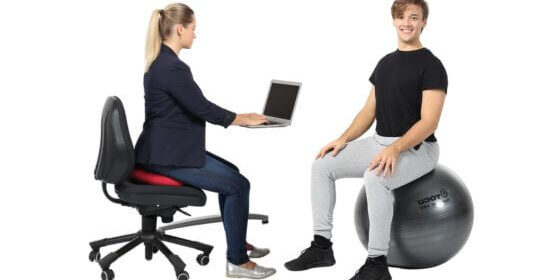Imagine sitting at your desk for hours, focused on your work. But after a while you notice a stiff shoulder, an aching back or even a headache. Do you know this? Many people who have sedentary jobs struggle with physical problems due to poor sitting posture.
The optimal sitting position at the desk plays a crucial role in physical well-being and health. It’s not just about a comfortable position, but more importantly an ergonomically correct alignment of your body to minimize strain and improve posture. In this blog article, we provide valuable tips for maintaining an upright posture at work.
What are the effects of a bad seating position?
A bad sitting position at work can have various long-term negative effects on the body. Here are some possible consequences of poor sitting posture:
- Back pain: A bad sitting position can lead to tension and pain in the back, especially in the lower back. Incorrect posture can overload the spine and intervertebral discs.
- Neck and shoulder discomfort: Leaning forward or raising the shoulders can cause tension and pain in the neck and shoulders. This can lead to headaches, stiffness and limited mobility.
- Deterioration of posture: In the long term, a bad sitting posture can lead to a change in the natural posture of the body. This can cause the muscles and ligaments to become accustomed to the incorrect alignment and make it more difficult to maintain good posture.
- Impaired blood circulation: An awkward sitting position can impair blood circulation, especially if the legs cannot be placed flat on the floor or the femoral artery is pinched off. This can lead to fatigue, swelling and numbness in the legs.
- Impaired breathing: A forward-leaning posture can impair breathing because the lungs cannot fully expand. This can lead to shallower breathing and reduced oxygen supply, which in turn can affect concentration and productivity.
- Muscle tension and weakness: A bad sitting position can overload certain muscles and weaken others. This can lead to imbalances that can cause muscular imbalances, tension and muscle weakness.
It is important to adopt a healthy sitting posture at work and take regular breaks to move and stretch. This can reduce the negative effects of a bad sitting posture and improve overall health and well-being.
What should you pay attention to for the right sitting position at the desk?
Sitting properly at your desk is critical to maintaining good posture and avoiding physical discomfort. Here are some important points to consider:
- Chair height: Make sure your chair is adjusted so your feet can be flat on the floor. Your knees should be bent at about a right angle. If your chair is not height adjustable, you can use a footrest if necessary.
- Backrest: Lean back slightly and use the backrest for support. The lumbar support should be at the level of the lower back to maintain the natural curvature of the spine.
- Sitting position: Sit as far back as possible on the chair and keep a distance of about one hand’s width between the front edge of the seat and the back of the knee. This allows good blood circulation and prevents pinching of the femoral artery.
- Armrests: The chair’s armrests should be adjusted so that your arms can rest on them in a relaxed manner without having to raise shoulders. This promotes relief of the shoulder and neck muscles.
- Table height: Make sure the table height is set so that your forearms are parallel to the floor when typing on the keyboard. Your elbows should be bent at an angle of about 90 degrees.
- Screen position: The screen should be at eye level so that you do not have to tilt your head up or down. The optimal distance to the screen is about one arm’s length.
It is important that you remain in this correct sitting position while working. Pay attention to your posture, avoid slipping into a slouched or forward-leaning position, and take regular short breaks to stretch and move around. Remember that ergonomics and movement are equally important to ensure optimal posture at work.
What is the importance of habits and prevention for a correct sitting position at the desk?
Habit formation and prevention are important factors in improving sitting posture at work. Conscious behavior and regular self-observation can promote healthy posture in the long term.
One way to make better posture at the desk a habit is to regularly observe yourself and make corrections when you notice you are getting into a bad sitting position. An upright sitting posture should become second nature by consciously focusing on how you are sitting over and over again and making corrections as necessary.
In addition, it is important to take regular breaks to relieve the body and prevent tension. A short break every 30 minutes to stand up, stretch or walk a few steps can already help to relax the body and increase concentration.
Another way to prevent bad posture is to adapt the working environment accordingly. An ergonomically designed workstation with a height-adjustable desk, ergonomic keyboard and mouse, and an adaptable office chair can help make it easier to maintain an upright sitting posture.
Ultimately, habit formation and prevention is about awareness of healthy posture and integrating movement and relaxation into everyday work. Through regular self-observation, targeted breaks and adaptation of the work environment, an improved sitting posture can be achieved in the long term.
Our TOGU experts advise:
An important tip for healthy sitting at a desk is to change your sitting position regularly. Avoid staying in a rigid position for long periods of time. Instead, consciously remind yourself to change your sitting posture regularly.
One way to implement this is through what is known as dynamic sitting. For example, you can change your sitting posture every 30 minutes by standing up, stretching or walking a few steps. These short bursts of movement stimulate blood circulation, relieve tension and take pressure off the spine.

